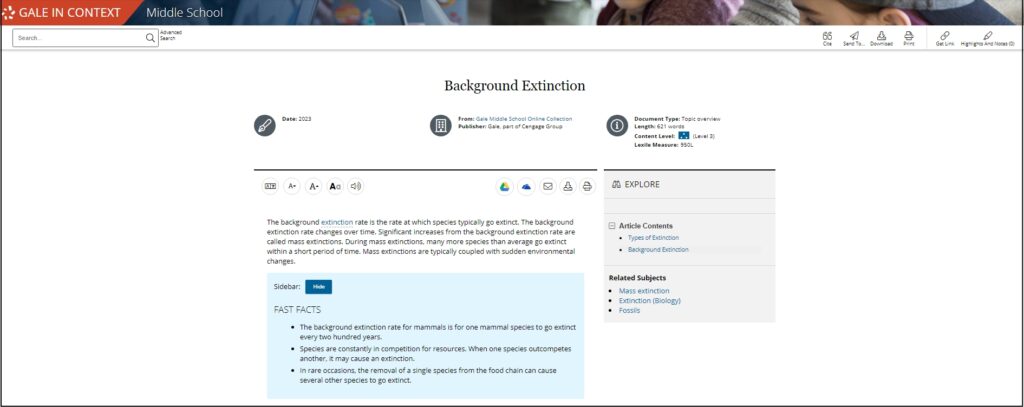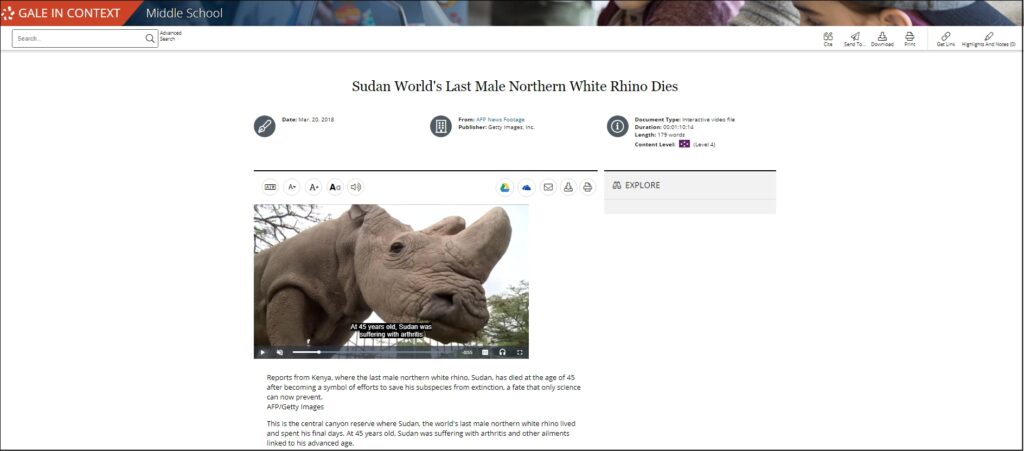| By Gale Staff |
Since the start of the twenty-first century, new initiatives in American education have stressed the importance of teaching science, technology, engineering, and mathematics (STEM) to help prepare students for jobs when they enter the workforce. Although readying students for future careers is an important goal of STEM, teachers may want to carve out some STEM education to include students’ interests and natural curiosity. Gale In Context: Middle School has numerous resources that will engage and excite students with a wide range of STEM-related subjects.
Students and teachers can explore an array of scientific topics and choose those which interest them most. The updated database for Gale In Context: Middle School includes resources on anatomy, such as in the portal about the brain, as well as resources covering earth science which can be found in the geology portal. For students who prefer stories about people who have made important contributions to STEM, they’ll also find resources that suit their interests. For instance, the database includes the Elizabeth Blackwell portal, which provides information about the first American woman to receive a medical degree. Still others may be interested in topics about major events in Earth’s history. These students may be interested in the new patterns of extinction portal, whose resources will help students better understand how and why extinction happens. Teachers can guide students’ research by helping them explore the different types of resources available that will spark their interest.

Understanding Extinction
Teachers with students who are already interested in extinction can guide them to the topic overview, where they’ll learn about what patterns extinctions have followed during Earth’s history. Students who understand the basics may not realize that extinction can occur because of natural pressures on a species—such as competition with other organisms—or because of human actions, such as overhunting and environmental damage. Furthermore, numerous extinctions can happen in a short period of time in an event called mass extinction. Students can also deepen their understanding by reading the reference articles “Mass Extinction” and “Background Extinction,” which give further insight into specific patterns.
Students who may not be as familiar with extinction can be guided to the video “Species Extinction and Exotic Species,” which provides them with an overview and explains why extinction can happen (for example, an increase in exotic species can take away resources from species already living in a particular ecosystem). This video will engage students by identifying the real-world effects of extinction and help them understand the topic’s importance.
Identifying Examples of Extinction
Students will also find resources that can help them understand more about specific examples of extinction. For instance, one of the most famous extinctions in Earth’s history is the mass extinction of dinosaurs. Students who already know about this may want to deepen their understanding by reading the article “Were the Dinosaurs Thriving before that Asteroid Obliterated Them?” which explains that dinosaurs were most likely facing threats to their existence before an asteroid hit. The article theorizes that the dinosaurs faced a “perfect storm” of threatening factors, including the asteroid impact, and that those combined factors caused their extinction.
Students can also learn about specific species and subspecies that have become extinct or nearly extinct during students’ own lifetimes. For example, the video “Sudan World’s Last Male Northern White Rhino Dies” covers the death of the rhinoceros subspecies. The video explains that the die-off happened mainly because of poaching and other human-caused factors. This example helps students understand that extinction is an ongoing threat and not just something that happened in the past.
They can also learn about species that have faced threats of extinction at various times for different reasons. For instance, the article “Antarctic Fur Seals, Once Hunted to Near Extinction, Now Face Climate Threat” explains that the seals were hunted for their fur in the 1800s, and that they nearly went extinct because of human overhunting. In the 1900s, however, new laws protected the seals, allowing the population to rebound. By the 2000s, the seals faced a new threat, as scientists believe that climate change is putting pressure on the population, observing that the seals have lower birth weights and other factors that indicate they’re facing food shortages. Scientists believe these food shortages are caused by climate change, as warmer waters have decreased the number of krill—a staple food for seals—in Antarctic waters.
Discovering Possible Effects of Extinction
The Patterns of Extinction portal also provides students with resources that discuss effects or possible effects of extinction. These types of resources are impactful because they discuss why the topic of extinction is important in the real world. In the video “A Tale of Two Urchins,” two different species of urchins, although related, have very different behaviors, which means they have different impacts on the ecosystems around them. The video helps students understand that the extinction of one species—even one whose relatives survive and thrive—may have major impacts on certain ecosystems.
The article “Mass Extinction Also Changed Ocean Ecology” explains that scientific research supports the idea that a mass extinction which happened about 250 million years ago had extreme effects on life in our oceans. Scientists believe that the effects are still apparent today because this extinction caused animals that hunted their own food to survive in larger numbers than organisms that filtered nutrients from the water. From this article, students will better understand the impact of extinction and how it can permanently affect life on Earth.



